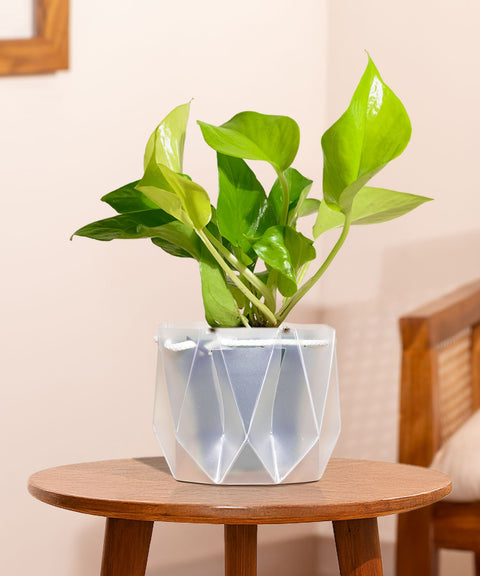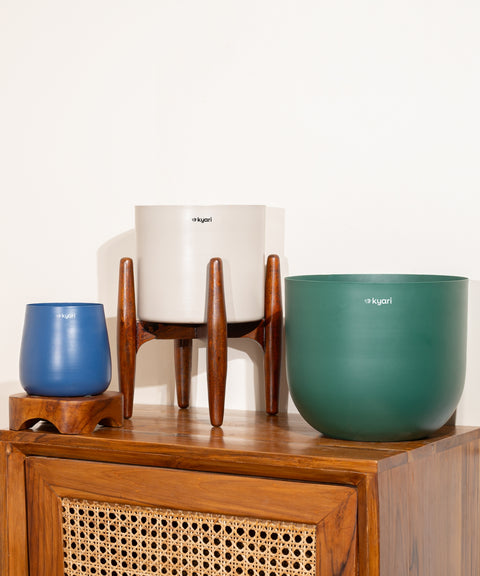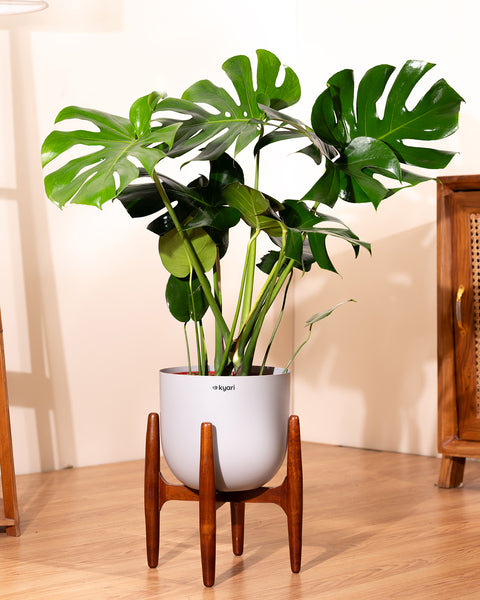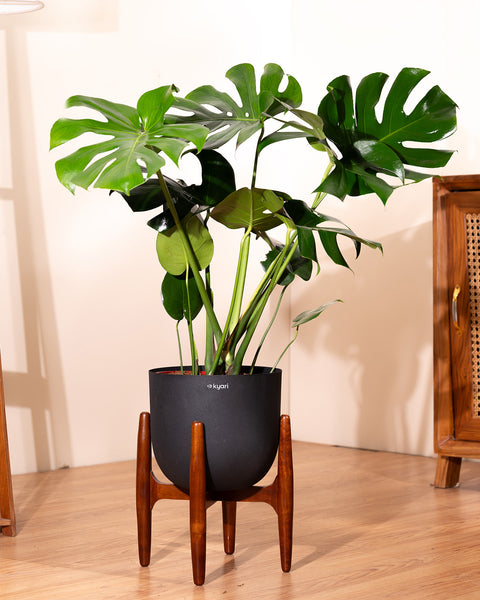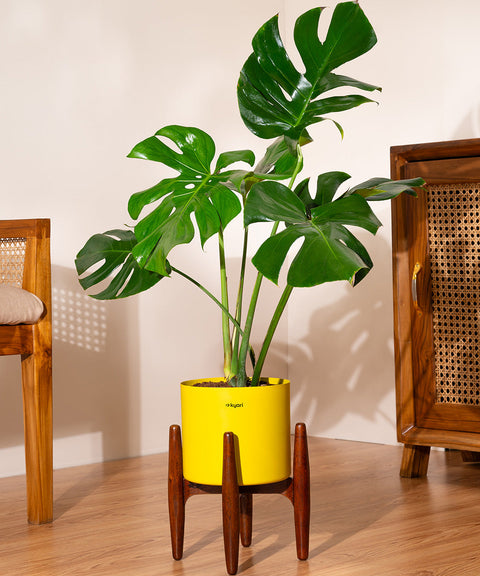Those people who love to see their home as a small nursery full of homely and indoor plants often suffer while choosing a perfect collection of plants for them to suit and cooperate with changing weather. Every piece of plant holds a special value in their hearts. It is undeniable that the greenery in the house reflects the positivity and calming atmosphere. Homely plants play a major role in maintaining that environment for you. Today, we will shed some light on one of those peace-generating and impressive plants named- the spider plant.
Spider plant is commonly used and planted piece of greenery to set the impression in the area. Chlorophytum comosum, or spider plant, is also known as airplane plant, spider ivy, and ribbon plant. Spider plants from Kyari are generally fast-growing plants if provided with friendly conditions. To make them grow perfectly, you are required to follow certain steps of care and supervision. This blog is presented to you as a spider plant care guide to make your plant survive and grow magnificently and how to care for spider plants.
How to Plant a Spider Tree Plant?
The process of growing or planting a spider plant includes several key steps:
1 Although they look awesome in a pot too, planting them in a basket and using them as a hanging planet will flourish their beauty to the next level. This is one of the ultimate tips for caring for spider plants.
2 Spider plant care guide also includes favorable climate conditions and soil so that their growth feels no barriers and they can sustain potentially.
3 Taking care of spider plants is an essential component to keep them alive and sustainable. You need to remember that an indoor spider plant and an outdoor spider plant both need special care.
4 Spider tree plants appreciate enough humidity and warm temperatures, so you are required to set the environment accordingly for them.
5 There are no such restrictions as to the time when you can grow a spider plant. A spider plant can be planted anytime and in any season through seeds or plantlets. Just ensure that they are taken care of perfectly.
How to Care for Spider Plants?
When raising a specific kind of plant, the need for sunlight, soil, fertilizer, water, temperature, and humidity changes accordingly. In the case of a spider plant, they demand utmost care and awareness.
Here is the list of some key factors to be considered while adopting a spider plant:
1 Light
Plants really can't grow when they are deprived of enough sunlight, and so a spider plant. Although spider plants don't prefer direct or extreme sunlight, they still need light shade to grow. When they are placed indoors, indirect sunlight suits them well. Direct sunlight can potentially damage the leaves of your spider plant. This is how you maintain spider plant care.
2 Soil
Here comes the core factor, which is watering the plant. Insufficient and excess water can do serious harm to your plant. Over-watering a spider plant can lead to root rot, which in turn can kill the plant, so try to maintain less moist soil for your plant by inconsistent watering. For amazing results, distilled water or rainwater can do wonders for the growth of a spider plant.
4 Temperature
The essence of temperature is huge for spider plant species. A warm environment is always ideal for indoor or outdoor spider plants. Between 55 and 80 degrees Fahrenheit, a spider plant grows well. In the process of Spider plant care, temperature needs to be maintained for the healthy living of your plant.
5 Humidity
When humidity levels go down, the leaves of a spider plant start turning brown, so you are advised to maintain proper humidity by regular misting. Spider plants prefer humid conditions around them. Keeping the humidity levels between 40-80% is a must for spider plants if you don't want to see their leaves scorch.
6 Fertilizer
One of the primary spider plant care tips includes fertilizer. Adding fertilizers to your plants is offering them extra care and concern. You can feed your plant with a water-soluble fertilizer and all-purpose granular. But remember to keep it in a moderate amount as feeding them excessively or inadequately can cause distress to the plant.
How to Fix Common Spider Plant Problems?
No matter how much you care for your spider plants, they still can be seen in some unfavorable conditions, which are mentioned below:
1 Repotting
When spider plants are provided with ideal conditions for them, they grow rapidly. As they grow, they need a larger space to spread and breathe. Hence, once they start growing, remember to change the size of their pot so that they do not feel restrictions and can bloom beautifully.
2 Infestation
Infestation in plants is a common problem irrespective of which species of plant it belongs to. Plant pests such as whiteflies, aphids, and spider mites are some general microorganisms that can leave a serious impact on your spider plant. You can deal with this issue by a simple step, that is, by rinsing the plant with water.
3 Yellow Leaves
Poor soil quality, insufficient water, and intense direct sunlight can lead to the yellowing leaves of your beloved spider plant. There is a very simple solution to combat this problem is just to provide the plant with fresh soil, timely watering, and partial or shady light. Spider plant care includes all these factors in an ideal manner.
Root Rot
Water is a mandatory component for the survival of a spider plant. But this is your reminder to maintain the balance here. Anything in excess can cause harm. Likewise, over watering a spider plant leads to root rot or even can end their life ultimately. Planting your spider plant in a well-draining pot can help you a lot and save it from root rot.
What are the Benefits of Spider Plants?
You are required to care for spider plants in order to fetch benefits from them. As we know, every kind of indoor or outdoor home plant serves a purpose or benefit. Similarly, a spider plant is also a bundle of joy and advantages for your house. Let's learn what those benefits are:
1 Cleaning Indoor Air
It is scientifically proven that a spider plant can effectively clean the air. It can absorb the harmful chemicals present in the air like xylene, benzene, carbon monoxide etc. Thus, we can say that spider plants are natural air purifiers.
2 Reduces Stress Levels
Spider plants are one of the therapeutic plants. It helps in improving the hormones of the human body which are related to stress. They reduce the stress and depression levels of the environment and generate calmness and peace.
3 An Appealing Plant
Apart from the benefits it offers, this piece of plant looks appealing and alluring when placed in a house. Whether planted in a hanging basket or a usual pot, it never fails to leave an impression. This plant can contribute to enhancing the greenery of your house.
Pet Friendly
Spider plants are pet-friendly indoor and outdoor plants. These spider plants are labelled as non-toxic plants for pets and animals by the American Society for the Prevention of Cruelty of Animals. When the right precautions are taken, spider plants are highly beneficial to be planted in your house.

FAQs on Spider Plants
No. Spider plants prefer to be placed in a light shade where they can avoid contact with direct sunlight. Direct sunlight is a big no for spider plants.
Spider plants are required to be put in a place where they can avoid direct sunlight and can breathe properly. A pot with ample space to grow and spread their roots will be a perfect place for them.
Spider plants don't demand very consistent watering, especially in the winter season. They can also grow perfectly with less supply of water. Excessive watering can cause damage to their leaves.
Wrapping Up!
No matter how much you care for your spider plants, they still can be seen in some unfavorable conditions, which are mentioned below:
1 Repotting
Spider plants are one the most recommended plants in terms of beauty and benefits. If they are treated with proper care and gratitude, they return it to you by providing peace and prosperity in your house. Also, they work as a showpiece no matter where you place them in your house, it always enhances the charm and elegance. Not only this, spider plants also come in different forms and species.
The non-toxic character of a spider tree plant is easily adaptable. By taking certain precautions, you can own a healthy spider tree plant, which can include proper humidity, temperature, watering, fertilizer, soil, and ideal sunlight. This blog is a guide to growing a healthy and prosperous spider plant in your house. Don't forget to explore a wide range of spider plant species, indoor spider plants, bedroom plants, and spider plants online in India only at Kyari.








 Limited Time Deal
Limited Time Deal
 BYOB - Small Plants
BYOB - Small Plants






























